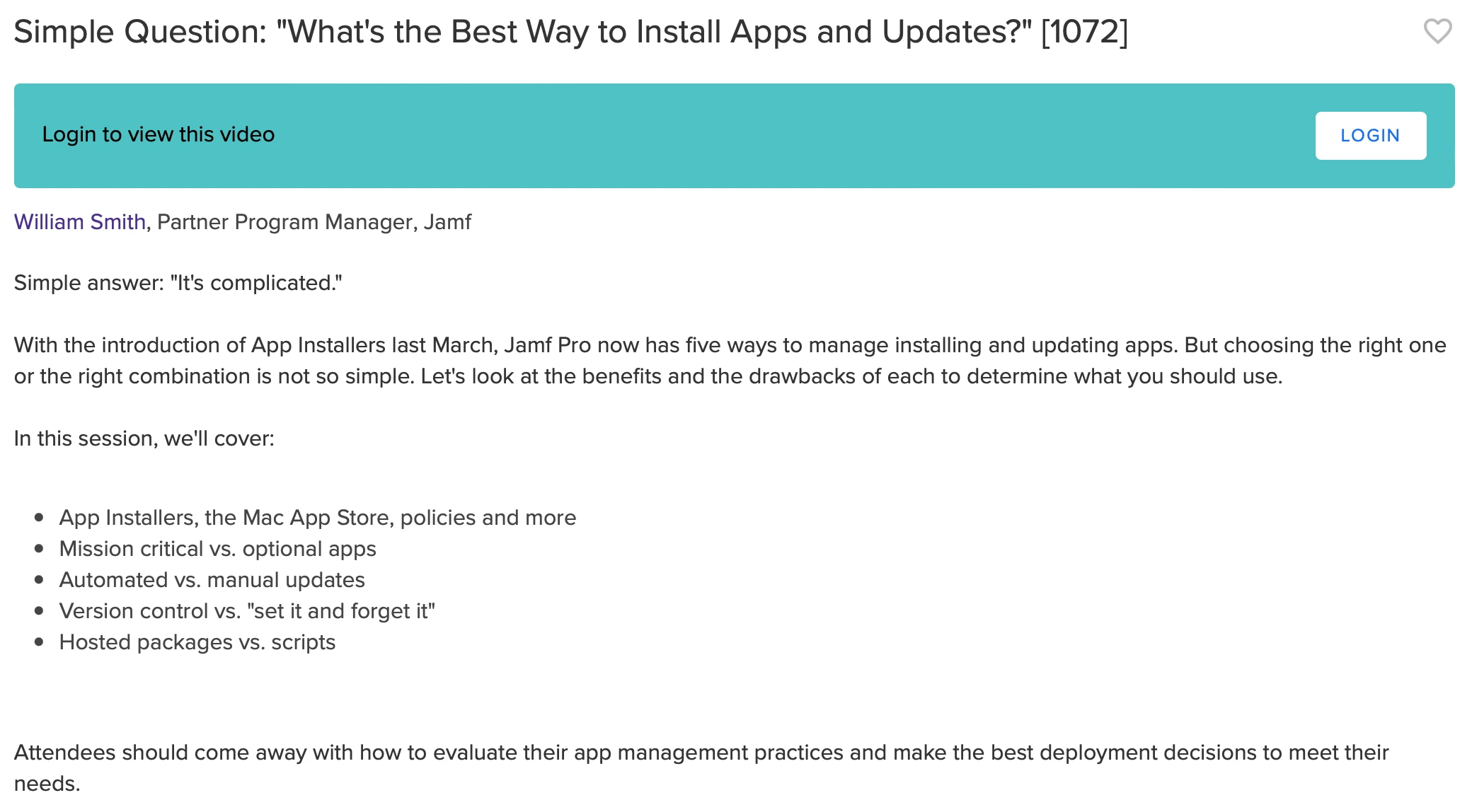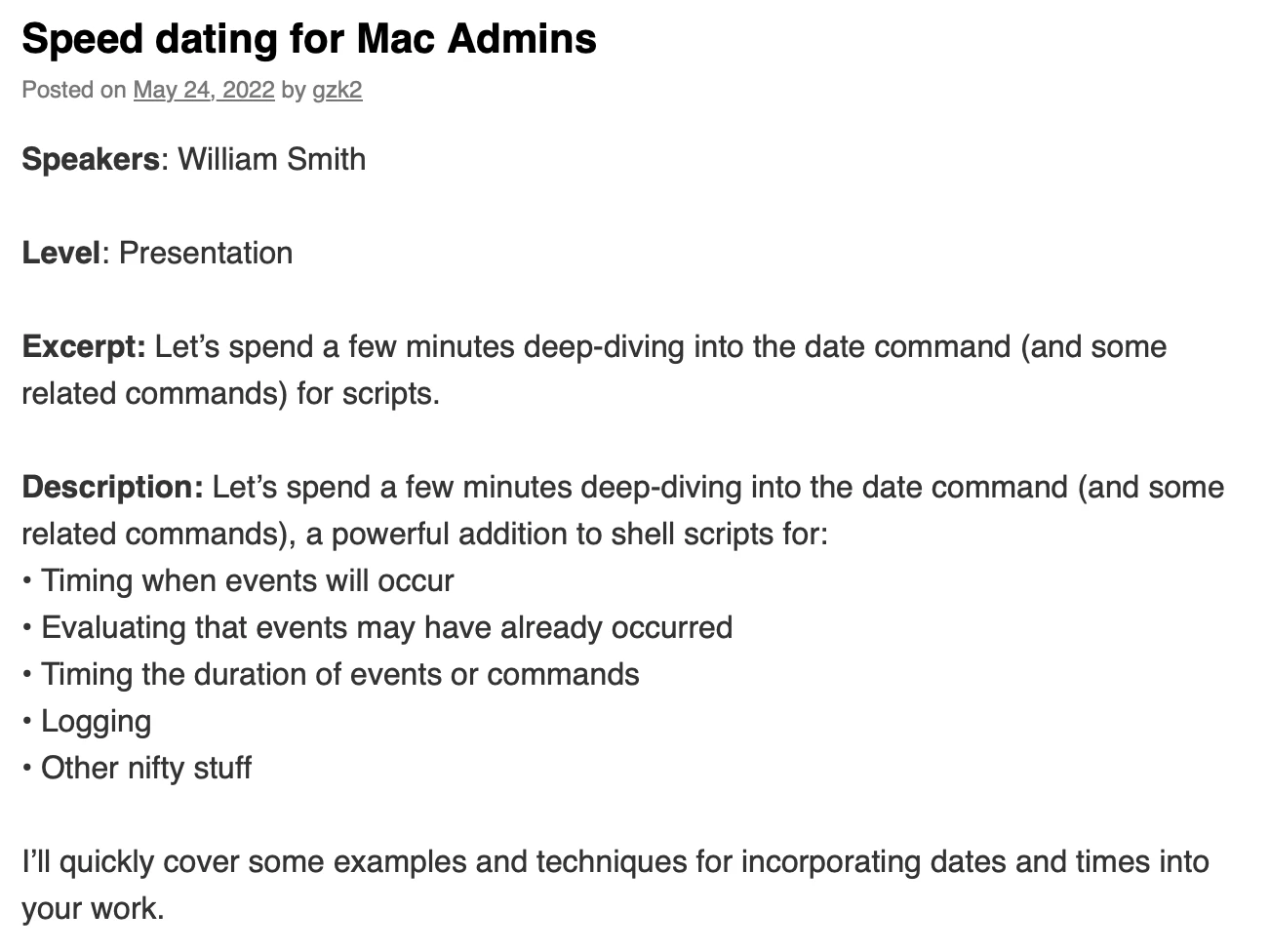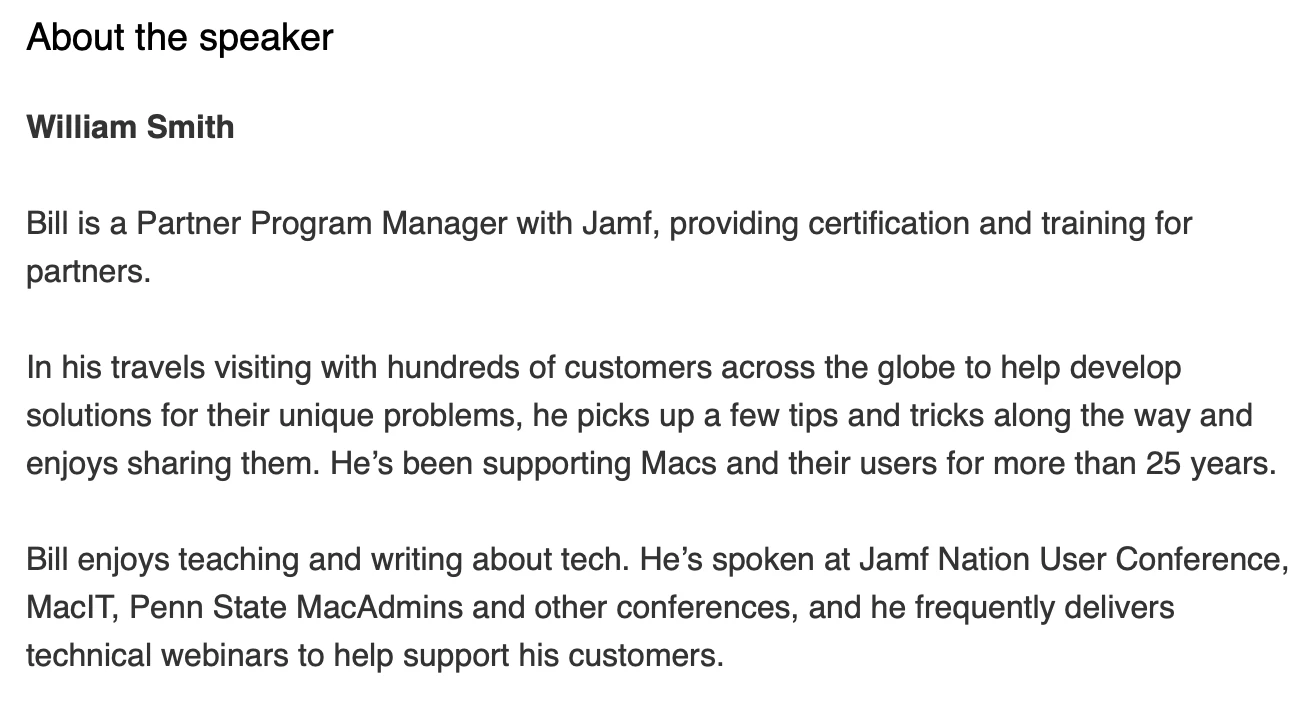A Read-only Friday post by William Smith
Every word is precious. You shouldn’t waste them.
Let’s keep this one short and sweet to let you get on with your homework.
A few Apple admins conferences, including the Jamf Nation User Conference (JNUC), have already opened their calls for proposals. Each conference may go by a slightly different name for submissions, but they’re all asking you for the same thing. They want to hear about your story.
By now, you should have a good idea if your story fits with the theme of the conference or conferences you’ve chosen. Remember, all you need to do is go watch some of the videos they’ve posted online from past conferences to see if your idea fits. If you’re in the Apple management or security space, you’re going to fit just fine.
What you’re going to submit is commonly known as an elevator pitch. Imagine you have this great idea and just so happen run into the decisionmaker on an elevator in a tall building. It’s now or never. As you ascend the building in the elevator you have that person’s attention for 30 seconds to make a brief introduction about you and your presentation topic and win them over.
Here’s my pitch from one of my JNUC 2022 presentations.

Parts of your pitch
Keep in mind the information you submit during this process is probably also what the conference is going to publish for attendees to help them choose their sessions. So, your audience is two-fold.
There’s not much you need to put together, but what you do put together has to be as compelling as possible. You’ll usually submit some or all the following:
- Your name, contact information, and a short bio
- A title for your presentation
- The intended audience
- The session type (workshop, lab, presentation, 5-minute quick talk, etc.)
- A description
- A short abstract (about a sentence) from your description
- Any additional information you’d like to provide
Most conferences accept presentation proposals through a website where you can create an account, log in, and review their submission forms before you propose anything. Go do that before you start writing your pitch! You’re not required to do everything at once.
As soon as you know the information they’re requesting and what you need to put together, create a new note in your favorite app of choice and assemble the pieces offline. Don’t try to compose your thoughts while filling out the forms. A simple browser refresh or errant swipe on your trackpad and you could lose your work. It always happens just after you’ve composed the most perfect sentence in the world. Trust me. I know.
Some forms like the one for the MacAdmins Conference at Penn State University limit the number of characters or words in your submission to make you tightly craft your thoughts. Every word is precious. You shouldn’t waste them.
Choosing a title
Conferences may have several tracks and presenters speaking at the same time in different halls. They’ll post a list of sessions for attendees to browse and choose which ones they want to attend.
The title of your presentation is the most important part of all your writing. In that list for attendees, it’ll be the biggest, boldest part of your presentation’s blurb and that’s what attendees are quickly scanning to make their decisions. It needs to make an impact.
Titles beginning with “How to…” are a surefire way to grab attention. They imply the audience will learn something. If you’re planning a presentation where you’ll be teaching a subject, this is a good place to start. Dale Carnegie’s 1936 book How to Win Friends and Influence People is one of the best-selling books of all time. It was the title that made people pick up the book.
For technical conferences, it never hurts to include technical jargon in the title that touches on your topic. When I present on scripting, I’ll include something like “Scripting 101”, “Scripting 201” or “Command Line”. That’s because many administrators find scripting challenging, and they want to learn as much as they can about it. Similar terms like “Jamf Pro API” are also attention-getters and draw an audience.
Sometimes, I’ll include something about the intended audience in the title to help someone browsing a conference list immediately identify with my sessions. Again, “Scripting 101” or “Scripting 201” indicate levels of experience from novice to more advanced. If I were to say “for Experts” in the title, I might get a smaller crowd looking for a deeper technical dive.
And I’ve had great results from simply stating the problem I’m going to help the audience solve. Blog posts and webinars I’ve done about “Reinstalling a Clean macOS with One Button” or “Administering Office 2016 for Mac” have always resonated highly with audiences. Try to keep your title as succinct and straightforward as possible.
Writing a presentation description
I follow a simple formula most of the time and it’s served me well. The first sentence should grab attention and stand on its own line. Here are a few I’ve used:
A sure way to get a software developer’s eyes rolling is to tell them “It should be easy…”
Where do I start with shell scripting?
Like chess, regex is easy to learn but can take a lifetime to master.
For my MacAdmins Conference Campfire presentation in 2022, I got straight to the point.

From there, I try to spend no more than two paragraphs telling my story and what the audience will learn from it. That’s usually not hard because I’m retelling what I learned myself. I explain my struggle (e.g. “I had to deploy 20,000 iPads worldwide in just 90 days.”), my methodology (e.g. “I had to figure out which countries have the Apple App Store available.”), and what I learned (e.g. “I had to find interesting alternatives for those countries that don’t have the Apple App Store.”)
Also, give a short agenda. If you can list three to five simple bullet points, you’ll quickly grab attention because people like reading lists. This list can later become part of the outline for your entire presentation, so think on it a while.
Finally, state a goal or an outcome from your session. Tell attendees what they’ll learn or how they can apply what they’ll learn in their jobs. The last line of my proposal for my MacAdmins Campfire session was:
I’ll quickly cover some examples and techniques for incorporating dates and times into your work.
Try to keep your entire description to about 200 words. Remember, you’ve got 30 seconds to make your pitch, but unlike an elevator your audience can move on any time they get bored reading. Use an app like Pages, Microsoft Word, or BBEdit to help you count characters and words automatically.
Writing an abstract
You may be asked to provide an abstract of your description. That’s simple to do.
Try to find one line in what you’ve written that nicely summarizes your presentation. Think of it like your title but as one full sentence. If you can’t find a sentence like that, write one to be your abstract and include it in your description.
Writing your bio
You’ll also need to submit a short description about yourself. Try to keep this to about 50-100 words. You can list your job title, organization, technical credits like Apple and Jamf certifications, or anything that may make you sound like the expert you are.

Generally, you’ll write this in the third person. Don’t say “I manage Macs for a Fortune 500 company.” Instead, say “Bill manages Macs for a Fortune 500 company.”
I have kind of a generic job title, so I sometimes like to explain what I do, which is “training and certifying Jamf partners to deliver services, like onboardings and training, to customers”. Explaining what you do will help someone reading about you understand you’re from the same background.
What you choose to say about yourself is completely up to you. You’re usually welcome to include something like, “When he’s not putting out fires and herding cats, Bill likes to go snowshoeing in regional parks.” Again, this helps others identify with your background. Everything you say is a potential point of discussion when audience members come up to you after your session to ask questions.
And once you’ve written your bio, you can reuse it for other conferences! Don’t reinvent the wheel, but you can tweak it a little for slightly different audiences.
Your homework
In a couple weeks, I’ll start talking about putting together your presentation slides — the fun and creative part but also the most tedious part. I’ll cover this over the next few posts. Until then, work on these things:
- In Finding Your Presentation Inspiration, I listed several conferences that would love to hear your ideas for a presentation. Pick those where you’d like to speak and see if they’ve made their calls for proposals. Two conferences, MacAdmins Conference and JNUC, are open right now. They’d be great places to start.
- Follow their instructions for creating accounts, which you’ll need before you can submit proposals.
- Once you’re logged in to an account, review their form. Write down the names of each field along with any limits, like character or word limits, or take screenshots.
- Compose each item of the form offline. This way, you can take your time to write the perfect sentence without fear of a browser refresh wiping it out. Take your time. Let yourself ruminate overnight and come back to what you’ve written. Fresh eyes help find typos and sometimes better ways of saying things.
- When you’re ready, copy/paste what you’ve written into the form. Then take a deep breath, and click Submit.
Now you’ll play the waiting game. This is always an exciting but anxious period. You’re hoping your proposal will be accepted. If this is your first time, maybe you’re hoping it won’t be accepted. But you’ve made the commitment to try anyway. 😬


